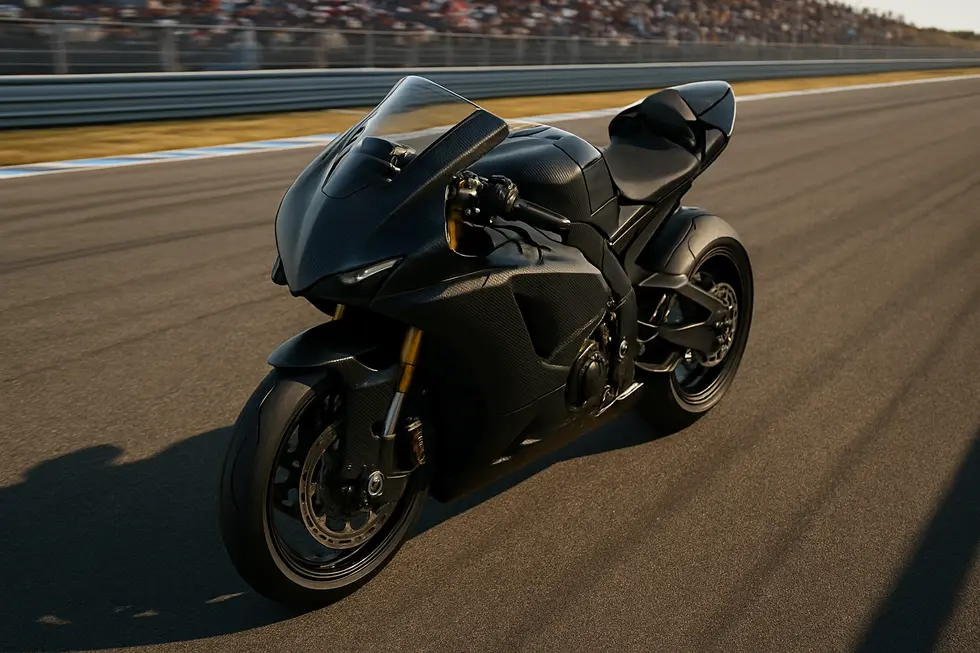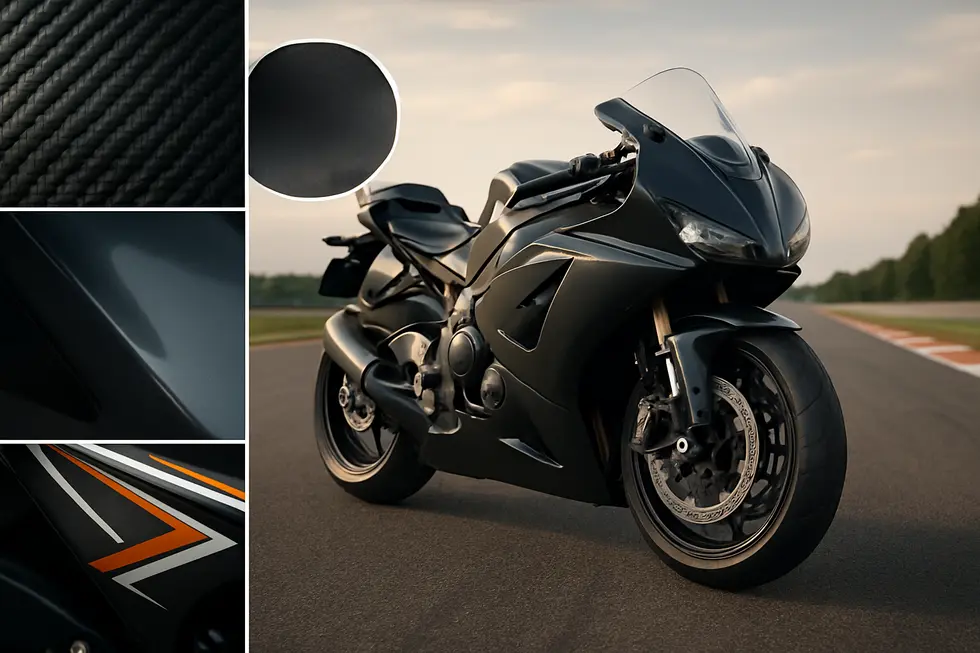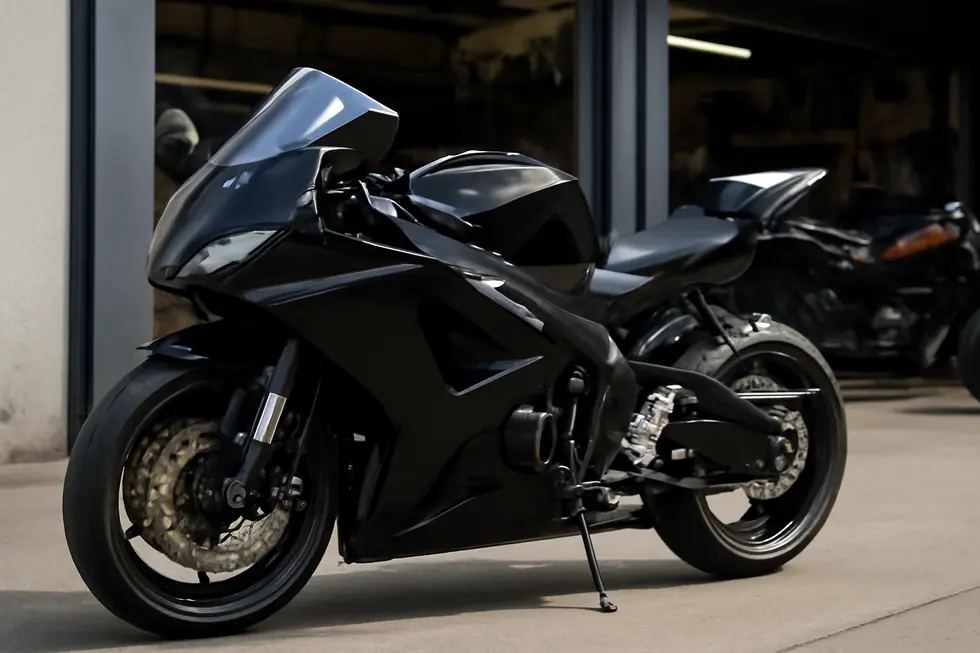Can You Paint Motorcycle Fairings? A Comprehensive Guide for Business Owners
September 14, 2025 | by summitfairings
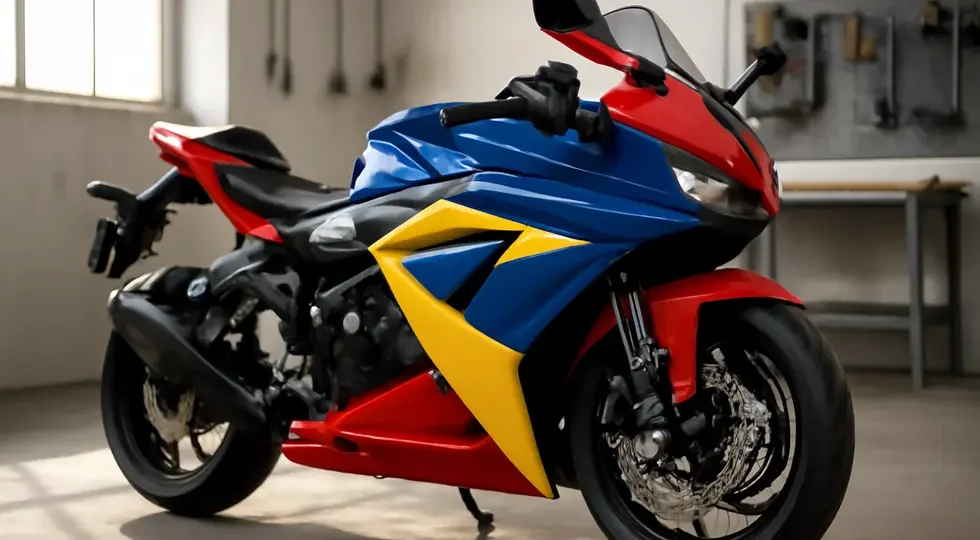
Introduction
Motorcycle fairings play a crucial role in both aesthetics and aerodynamics, making their appearance a key factor for owners and businesses alike. Understanding whether you can paint motorcycle fairings is essential knowledge for shops and service providers looking to expand their offerings or enhance customization options. This guide equips business owners with insight into the types of materials used in fairings and how their unique properties affect paint application. It details the critical steps of surface preparation, priming, and the actual painting process that ensure professional-quality results. Furthermore, it distinguishes between DIY approaches and professional techniques, helping businesses decide their best operational strategies. The guide also covers protective finishing methods that maintain longevity and UV resistance, an often overlooked but vital consideration for outdoor use. Finally, it highlights valuable tutorials and the role of custom paint shops to empower your business with expert knowledge and service connections. Exploring each of these facets creates a well-rounded understanding crucial for delivering durable, high-quality painted fairings that satisfy customers’ demands and protect your business reputation.
Tables of Contents
Chapter 1: Understanding If You Can Paint Motorcycle Fairings: Material Types and Feasibility
- How Fairing Materials Influence Paint Adhesion and Longevity
- Mastering Surface Preparation: Key Steps for Painting Plastic and Fiberglass Motorcycle Fairings
- Choosing the Right Paint and Primer for Durable Motorcycle Fairing Finishes
- Balancing Quality and Cost: Professional vs. DIY Approaches to Painting Motorcycle Fairings
- Ensuring Durable Beauty: Long-Term Feasibility and Care for Painted Motorcycle Fairings
Chapter 2: Essential Steps in Can You Paint Motorcycle Fairings: Preparation, Priming, and Painting Process
- Mastering Surface Preparation for Painting Motorcycle Fairings: Cleaning, Sanding, and Masking Techniques
- Mastering Priming for Motorcycle Fairings: The Key to Long-Lasting, Flawless Paint Adhesion
- Mastering the Painting Stage: Techniques for Smooth, Even Coats and Durable Finishing on Motorcycle Fairings
- Refining Your Motorcycle Fairings: The Crucial Role of Sanding, Polishing, and Clear Coating After Painting
- Optimizing Environment and Quality for Durable Motorcycle Fairing Paint Jobs
Chapter 3: DIY vs Professional Approaches to Can You Paint Motorcycle Fairings: Tools and Techniques
- Mastering Surface Preparation and Primer Application: DIY Tips Versus Professional Precision
- Choosing Between DIY Spray Cans and Professional Spray Guns for Painting Motorcycle Fairings
- Mastering Application Techniques: Wet Sanding, Layering, and Clear Coating for Motorcycle Fairings
- Comparing DIY and Professional Painting: Skills, Costs, and What’s Within Your Reach
- Achieving Smooth and Durable Motorcycle Fairing Finishes: A Detailed Look at DIY Versus Professional Results
Chapter 4: Protective Finishing in Can You Paint Motorcycle Fairings: Clear Coats and UV Resistance
- How Clear Coats Shield Motorcycle Fairings with Gloss and UV Protection
- How UV-Resistant Clear Coats Preserve Motorcycle Fairings’ Vibrant Finish
- Mastering Clear Coat Application for Lasting UV Protection on Motorcycle Fairings
- Enhancing Durability with Clear Coats, Ceramic Coatings, and Wax for Painted Motorcycle Fairings
- Material Compatibility and Essential UV Protection in Motorcycle Fairing Finishes
Chapter 5: Resources and Services Relating to Can You Paint Motorcycle Fairings: Tutorials and Custom Paint Shops
- Mastering DIY Painting Techniques for Motorcycle Fairings: Affordable and Effective Customization
- Expert Craftsmanship and Customization: What Professional Motorcycle Fairing Paint Shops Bring to Your Bike
- Mastering Advanced Repair and Finishing Techniques for Motorcycle Fairings: Expert Insights from Tutorials and Custom Paint Shops
- Exploring Diverse Customization Paths Beyond Painting in Motorcycle Fairing Services
- Empowering Motorcycle Fairing Painting: From DIY Tutorials to Digital Marketing for Custom Shops
Chapter 1: Understanding If You Can Paint Motorcycle Fairings: Material Types and Feasibility
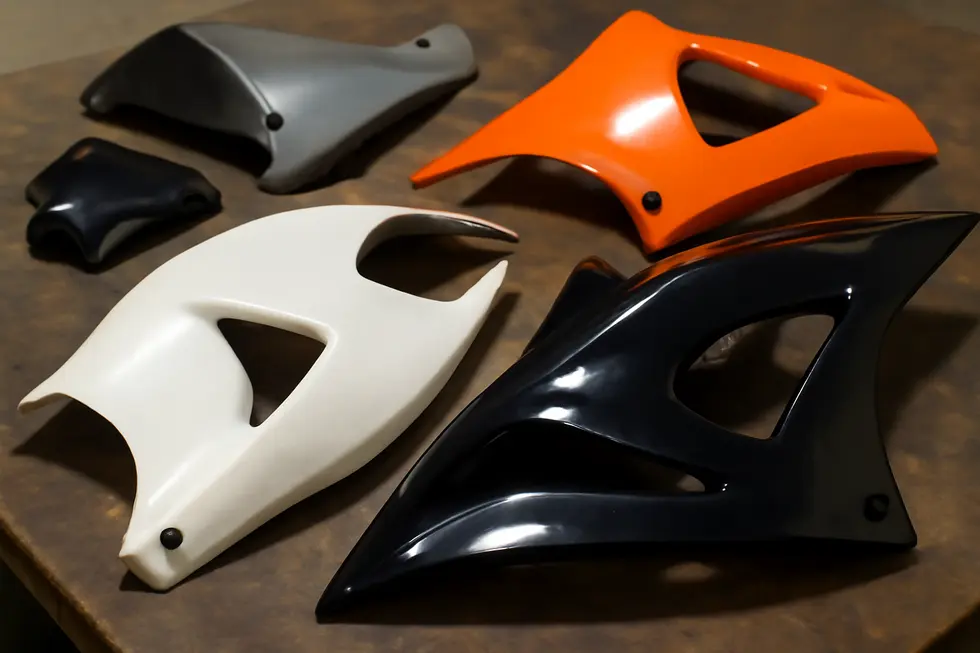
1. How Fairing Materials Influence Paint Adhesion and Longevity
Painting motorcycle fairings is feasible, but success depends heavily on the fairing’s material. Most fairings are made from plastics like ABS, polycarbonate, or fiberglass—each requiring meticulous preparation for paint to adhere properly. Thorough cleaning removes oils and contaminants, while sanding roughens the surface, creating a better bond. Using primers specially formulated for plastics acts as a critical adhesion promoter, ensuring paint layers do not peel prematurely. Selecting paint designed for automotive plastics is essential, offering flexibility and chip resistance that ordinary paints lack. After the paint, applying a clear coat protects against UV rays and road debris, preserving vibrancy and durability. Advanced protective coatings, such as ceramic-infused layers, further enhance scratch resistance and weatherproofing, extending the finish’s lifespan. Understanding these material impacts is vital before painting, guiding the preparation and products used for a long-lasting, professional-quality result. For more on finding quality motorcycle fairings, explore affordable options and tips.
2. Mastering Surface Preparation: Key Steps for Painting Plastic and Fiberglass Motorcycle Fairings
Proper surface preparation is crucial for painting motorcycle fairings made from plastic or fiberglass. Start by thoroughly cleaning the surface to remove grease, dirt, and dust, ensuring paint adhesion is not compromised. Light sanding with fine-grit sandpaper creates a receptive texture for primer and paint, smoothing out minor imperfections. Damaged sections, such as cracks or chips, require repair through fillers or plastic welding before moving forward. Using a primer compatible with flexible plastic surfaces, such as ABS, enhances paint durability and ensures a professional finish. Applying multiple thin paint coats rather than a single thick layer prevents runs and promotes even coverage. Masking surrounding areas is essential to avoid overspray and protect your bike’s other parts. For advanced cleaning, technologies like laser paint removal can safely strip old layers without damaging the material but need specialized equipment. Following these steps guarantees vibrant, long-lasting paintwork that withstands environmental wear. For detailed visual guidance, explore repair tutorials and surface prep tips and consult resources like this spray paint application guide.
3. Choosing the Right Paint and Primer for Durable Motorcycle Fairing Finishes
Painting motorcycle fairings demands careful selection of paint and primer tailored to the fairing material to ensure lasting adhesion and a professional look. Since most fairings are made from plastics like ABS or fiberglass, using a primer formulated specifically for those surfaces is critical. Applying plastic primer on ABS or fiberglass primer on fiberglass fairings creates a stable base for the topcoat, preventing peeling or cracking.
For the paint itself, two-component (2K) aerosol paints are preferred for their toughness and resistance to chips. These paints cure harder than single-component options, offering a finish comparable to professional spray equipment without complex setups. Applying multiple thin coats after a fully cured primer promotes even coverage and reduces runs. A final clear coat adds gloss and shields the paint from environmental damage. Allowing sufficient curing time, often 24 to 48 hours, guarantees the paint fully hardens and bonds.
Following these steps is essential; improper primer or paint choice often results in poor adhesion and compromised durability. For a deeper dive into fairing options and customization, visit Explore the Best Motorcycle Fairings at Summit Fairings.
Additional guidance and visual demonstrations can be found through tutorials explaining the entire painting process, including surface repair and paint mixing techniques.
4. Balancing Quality and Cost: Professional vs. DIY Approaches to Painting Motorcycle Fairings
Painting motorcycle fairings can be tackled both professionally and as a DIY project, each with distinct advantages and challenges. Professional painting involves meticulous surface preparation—thorough sanding, priming, and cleaning—using high-grade, flexible paints designed for plastic substrates. Experts work in controlled environments with spray booths and advanced tools like airbrushes, ensuring color accuracy and a durable, chip-resistant finish. This process is time-intensive and costly but yields superior longevity, UV resistance, and a flawless appearance.
Conversely, DIY painting offers a cost-effective and faster alternative, relying on consumer-grade or specialty paints applied with airbrushes or spray cans at home. While achievable, achieving a smooth, long-lasting finish requires careful preparation and patience. DIY results often vary in durability and consistency, with a greater risk of imperfections and shorter lifespan.
Choosing between these approaches depends on budget, skill level, and the desired finish quality. For enthusiasts seeking a professional-grade, lasting transformation, expert services are ideal. Those with time and dedication can pursue DIY painting with proper materials and techniques. For more insights on motorcycle fairings, explore detailed resources like the affordable and diverse motorcycle fairings at Summit Fairings.
For additional guidance, see tutorials such as “How to Repair Paint Cracks in Motorcycle Fairings” demonstrating practical DIY methods. (Source: https://www.youtube.com/watch?v=bxRE5Lyfw)
5. Ensuring Durable Beauty: Long-Term Feasibility and Care for Painted Motorcycle Fairings
Painting motorcycle fairings offers a practical way to customize or restore your bike, but its long-term success depends on meticulous preparation and maintenance. Fairings, often made from plastic or fiberglass, must be cleaned thoroughly and sanded to promote strong paint adhesion. Using automotive-grade primers and paints designed for plastics ensures durability. Clear coats protect against environmental factors like UV rays and debris, preserving the finish’s vibrancy. After painting, regular gentle cleaning with mild detergents and avoiding harsh chemicals or abrasive tools help maintain the surface integrity. Shielding the bike from prolonged sun exposure and storing it indoors or under covers significantly reduces paint degradation. While vinyl wrapping can shield fairings and last several years, it generally lacks the finish quality and permanence of well-applied paint. Following these care practices enables painted motorcycle fairings to retain their aesthetic appeal and withstand wear over time. For more insights on fairing options, explore our guide on affordable motorcycle fairings at Summit Fairings.
Reference: https://www.cbr300forum.com/threads/frame-paint.28024/
Chapter 2: Essential Steps in Can You Paint Motorcycle Fairings: Preparation, Priming, and Painting Process
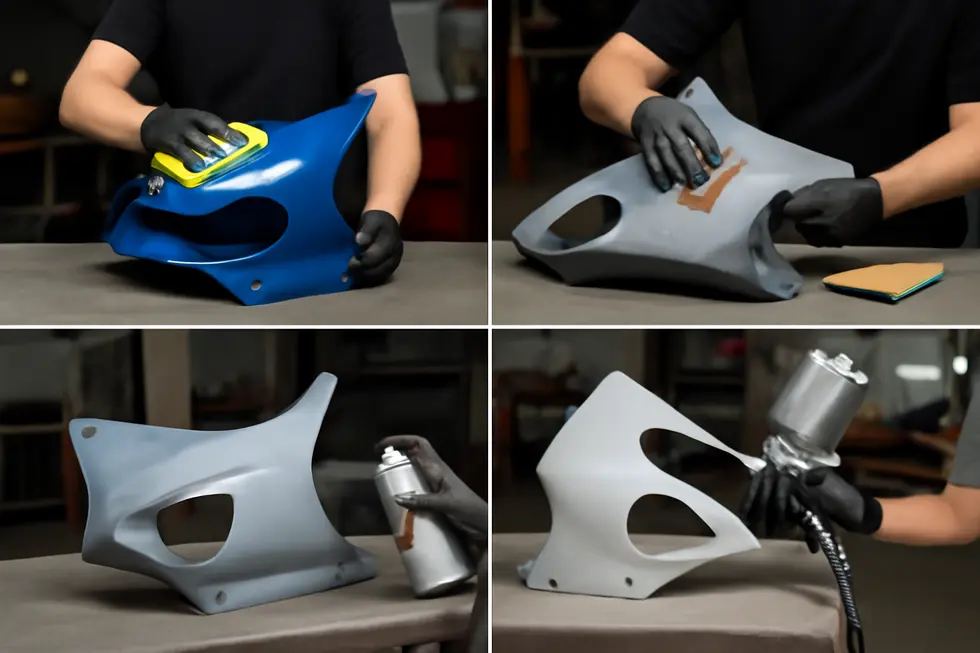
1. Mastering Surface Preparation for Painting Motorcycle Fairings: Cleaning, Sanding, and Masking Techniques
Successful painting of motorcycle fairings starts with meticulous surface preparation, which directly impacts paint adhesion and finish durability. Begin by thoroughly cleaning the fairings to eliminate dirt, grease, and residues using a degreaser or appropriate cleaner. This step ensures paint bonds properly without imperfections. Next, gently sanding the surface with fine-grit sandpaper (typically 400-600 grit) removes gloss and minor flaws, creating the needed texture for primer adherence. Masking is equally essential: carefully cover mounting points and non-painted areas with painter’s tape and protective sheets to prevent overspray and preserve clean edges. Applying a plastic-compatible primer after these steps establishes a uniform, receptive base for paint, reducing risks of peeling or cracking. These preparation techniques lay the foundation for a smooth, professional result, whether you choose DIY methods or professional painting. For further insight into selecting and prepping your fairings before painting, explore detailed options at Summit Fairings’ resource page. To enhance your spray application skills and product choices, consult comprehensive guidelines available from paint experts here.
2. Mastering Priming for Motorcycle Fairings: The Key to Long-Lasting, Flawless Paint Adhesion
Priming motorcycle fairings is vital to achieving a smooth, durable finish by creating a solid base for paint adhesion. Since fairings are usually made of plastic or fiberglass, surfaces must be meticulously cleaned and sanded first to remove contaminants and provide texture for primer bonding. Applying a plastic-specific primer ensures the paint sticks properly, preventing peeling or chipping caused by environmental factors or impact. After the primer dries, a light sanding smooths imperfections and readies the surface for paint application. Painting over a well-primed fairing with thin, even coats results in a vibrant, lasting finish resistant to wear. This step transforms raw fairings into canvas ready for customization or restoration, greatly extending the life and appearance of your paint job. For detailed guidance on primer application techniques, see expert tips on painting motorcycle fairings.
3. Mastering the Painting Stage: Techniques for Smooth, Even Coats and Durable Finishing on Motorcycle Fairings
Achieving a flawless paint job on motorcycle fairings hinges on applying multiple thin, even coats rather than one heavy layer. Using spray paint or an airbrush ensures better control, producing a smooth and consistent finish. Maintaining a steady distance and motion during application prevents runs and uneven coverage. Between coats, allowing proper drying time is essential to build depth and durability without compromising adhesion.
Once the final color layers are applied, sealing with a clear coat not only enhances gloss but also safeguards against UV damage and environmental wear. The clear coat’s protective qualities extend the vibrancy and longevity of your paint, especially important for motorcycles exposed to sun and elements.
Working in a dust-free environment and using primers and paints designed for plastics like ABS enhances adherence and finish quality. Finally, careful curing and gentle handling during reinstallation protect the new finish from stress and cracking. For detailed visual guidance, tutorials such as those showing methods for block sanding and airbrushing are valuable resources. More insights on selecting and customizing fairings can be found at Explore the Best Motorcycle Fairings at Summit Fairings.
4. Refining Your Motorcycle Fairings: The Crucial Role of Sanding, Polishing, and Clear Coating After Painting
Achieving a flawless finish on motorcycle fairings goes beyond applying paint; the post-painting process is vital for durability and visual appeal. Once your paint has thoroughly dried and cured, begin with wet sanding using progressively finer grits—from about 600 up to 2000. This smooths out any imperfections such as orange peel texture or dust nibs, creating an even surface. Next, polishing with a suitable compound restores the paint’s gloss and depth, removing sanding marks and enhancing clarity. The final essential step is applying multiple layers of clear coat; this seals the paint, offers protection against UV rays, scratches, and chemicals, and boosts shine. Light sanding between clear coats can improve smoothness further. To maintain the finish, keep the surface clean, dry, and avoid harsh washing or prolonged sun exposure. These finishing touches ensure your painted fairings remain vibrant and resilient. For a comprehensive visual guide on these post-painting steps, check out this Motorcycle Fiberglass Fairing Repair and Painting Tutorial. For more insights on selecting and caring for your motorcycle parts, explore discover affordable motorcycle fairings at Summit Fairings.
5. Optimizing Environment and Quality for Durable Motorcycle Fairing Paint Jobs
Painting motorcycle fairings demands careful attention to environmental and quality factors during preparation, priming, and painting phases to achieve a lasting, professional finish. Using high-quality, low-VOC paints and primers minimizes harmful emissions while enhancing adhesion and durability. A clean, dust-free workspace with proper ventilation is essential to avoid contaminants that degrade paint quality and pose health risks. Preparation begins with thorough cleaning using bike-safe, gentle products, followed by light sanding to promote surface grip. Selecting fairings made of durable plastics, such as ABS, improves paint endurance against UV and wear. Primers designed specifically for plastics ensure proper bonding, applied evenly in well-ventilated surroundings. Painting involves multiple thin coats of automotive-grade paint for depth and evenness, topped with a protective clear coat or film to shield against chips and environmental damage. Personal protective equipment and proper surface protection safeguard the painter and surroundings, ensuring safety and minimizing overspray. This diligent process results in vibrant, durable finishes that withstand road and weather hazards, extending the fairings’ lifespan. For more insights on quality preparation and materials, explore expert motorcycle fairings resources.
Chapter 3: DIY vs Professional Approaches to Can You Paint Motorcycle Fairings: Tools and Techniques
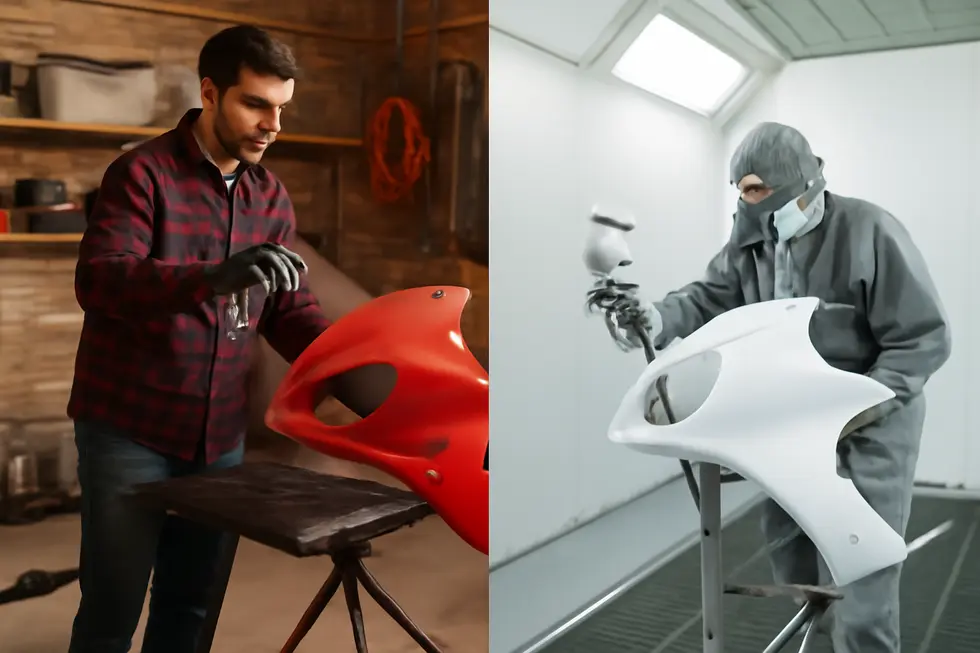
1. Mastering Surface Preparation and Primer Application: DIY Tips Versus Professional Precision
Painting motorcycle fairings demands meticulous surface preparation and primer application, whether tackled as a DIY project or entrusted to professionals. DIY enthusiasts begin by thoroughly cleaning the fairings to remove grease and dirt, then carefully sanding with fine-grit paper (typically 400-600 grit) to create a smooth surface conducive to paint adhesion. After cleaning with isopropyl alcohol or a degreaser, they apply compatible primers via spray cans or basic spray tools in multiple light, even layers to prevent runs. A gentle sanding after primer drying refines the surface for the color coat.
In contrast, professional painters employ advanced cleaning agents and may use media blasting or specialized sanders for flawless surfaces. They inspect and repair cracks or damage before priming with adhesion promoters tailored for plastics, applying primers with precision spray guns under controlled conditions. Professionals refine primer coats using wet sanding to achieve ultra-smooth finishes, essential for durable, high-quality results.
While DIY methods can yield respectable finishes with patience and care, professionals deliver superior durability, precision, and aesthetics, especially when handling repairs or custom designs. For more detailed insights on motorcycle fairing preparation and painting, explore this comprehensive guide.
For step-by-step instructions on cleaning, sanding, and primer application, visit PaintForMotorcycles.com.
2. Choosing Between DIY Spray Cans and Professional Spray Guns for Painting Motorcycle Fairings
Painting motorcycle fairings demands the right tools to achieve a quality finish, where the choice between DIY spray cans and professional spray guns plays a crucial role. Spray cans offer accessibility and ease, enabling hobbyists to apply multiple thin coats for a smooth, glossy look without heavy equipment. Proper preparation, ventilation, and safety gear remain essential to avoid issues like orange peel texture. Conversely, professional spray guns provide superior control over paint flow and atomization, producing a flawless, durable finish favored for custom or repair work. These systems require more investment in equipment and skill but handle a wider range of paint types, including metallics and custom blends. Depending on your experience, budget, and project scope, either method can yield satisfying results. For enthusiasts keen on mastering spray can techniques, tutorials like the DIY 2K Clear Coat Spray Can Tutorial offer valuable guidance. For detailed insights on quality finishes, exploring options at Summit Fairings provides inspiration and support.
3. Mastering Application Techniques: Wet Sanding, Layering, and Clear Coating for Motorcycle Fairings
Painting motorcycle fairings requires precision in application techniques such as wet sanding, layering, and clear coating, whether approached as a DIY project or by professionals. DIY enthusiasts often rely on spray cans or airbrushes, meticulously sanding with fine grit (around 2500) to smooth imperfections between paint layers. Applying thin coats with adequate drying times prevents runs, while a careful clear coat adds gloss and protection, though it may require sanding and polishing to correct surface texture issues like orange peel.
In contrast, professionals utilize advanced spray guns and precise wet sanding methods with ultra-fine grits and water to avoid damaging the surface. They measure paint thickness and execute paint correction for a flawless, durable finish. Layering and clear coating are handled with expertise, delivering a showroom-quality look that withstands the elements longer.
While DIY methods can yield decent results with patience, the control and experience professionals bring ensure superior longevity and finish quality. Those seeking to enhance their technique can find valuable tutorials, such as the video “Why Your Spray Paint Job Sucks (and how to fix it),” for expert tips on achieving smooth, even coats. For further insights on fairing customization, explore the best motorcycle fairings to complement your fresh paintwork.
4. Comparing DIY and Professional Painting: Skills, Costs, and What’s Within Your Reach
Painting motorcycle fairings offers two main paths: undertaking the project yourself or entrusting it to experienced professionals. DIY painting demands moderate to advanced skills, patience, and a suitable workspace equipped with tools like airbrushes, sandpaper, primers, and quality paints. Careful surface preparation and multiple paint layers are crucial to avoid uneven finishes and ensure durability, but costs stay relatively low since you mainly invest in materials. On the other hand, professional services deliver superior results through advanced techniques such as expert surface treatment, custom airbrushing, and durable clear coatings. Skilled painters achieve glossy, long-lasting finishes that boost both aesthetics and resale value, albeit at a higher price and requiring access to local shops. Choosing between these options depends on your budget, time, skill level, and desired outcome. For enthusiasts seeking guidance on DIY techniques, detailed tutorials online can provide invaluable visual and step-by-step support, making the process more accessible and rewarding. For comprehensive options and expert advice, consider exploring unmatched choices in motorcycle fairings available through dedicated resources like Summit Fairings.
For a practical, visual DIY guide, this tutorial on repairing paint cracks in motorcycle fairings offers detailed insights: https://www.youtube.com/watch?v=bxRE5LyBfw4
5. Achieving Smooth and Durable Motorcycle Fairing Finishes: A Detailed Look at DIY Versus Professional Results
Painting motorcycle fairings offers riders a chance to personalize or restore their bikes, but the quality of the finish varies notably between DIY and professional approaches. DIY painting demands thorough surface cleaning, sanding, and priming before applying multiple thin coats of paint and a protective clear coat. While affordable and customizable, DIY projects often reveal imperfections such as uneven textures, dust inclusion, or subtle paint runs due to limitations in tools and environment control. In contrast, professionals deploy advanced equipment within controlled settings, using premium primers, base coats, and custom airbrushing techniques to achieve flawless, glossy finishes. These results showcase deeper color consistency and enhanced durability resistant to UV damage and chipping. The choice between DIY and professional painting hinges on the desired finish quality, budget, and time commitment, with professional services excelling in longevity and aesthetic precision. For enthusiasts keen on improving their skills, comprehensive tutorials on preparation and painting techniques are invaluable (see resource). For detailed information on motorcycle fairings selection and customization, explore the Summit Fairings blog.
Chapter 4: Protective Finishing in Can You Paint Motorcycle Fairings: Clear Coats and UV Resistance
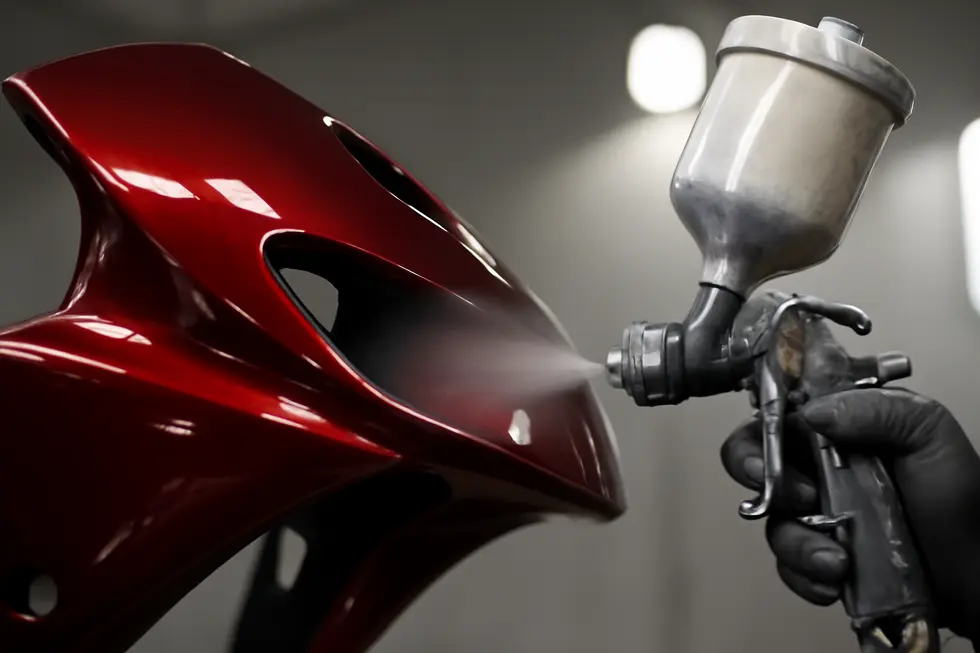
1. How Clear Coats Shield Motorcycle Fairings with Gloss and UV Protection
Clear coats are essential in protecting motorcycle fairings after painting. They form a resilient barrier that seals the paint, guarding it against UV rays, chemicals, abrasions, and weather exposure. This protection is vital since motorcycles are often exposed to harsh sunlight, which can fade colors and dull finishes over time. By applying a clear coat, the underlying paint remains vibrant and resistant to damage from road debris and gasoline spills. Beyond durability, clear coats enhance the fairings’ gloss, restoring or maintaining their showroom shine and simplifying maintenance by repelling dirt and grime. Advanced protective layers, such as ceramic coatings, can further complement clear coats to maximize UV resistance and chemical durability. Incorporating clear coats is therefore a fundamental step that ensures both the longevity and aesthetic appeal of painted motorcycle fairings. For further insights into quality finishing techniques, see this guide to high-performance clear coats. To explore fairing options that stand up to such protective treatments, visit our detailed coverage on quality motorcycle fairings.
2. How UV-Resistant Clear Coats Preserve Motorcycle Fairings’ Vibrant Finish
Achieving durable UV resistance in motorcycle fairings hinges on high-quality clear coats enriched with UV inhibitors. These transparent layers shield painted ABS or fiberglass surfaces from ultraviolet rays that cause color fading, chalking, and plastic degradation. Unlike single-stage paint systems, modern multi-layer clear coats deliver a robust barrier that maintains gloss and pigment vibrancy over time, essential for bikes exposed to constant sunlight. Beyond factory finishes, riders can enhance UV protection by using waxes, ceramic coatings, and protective covers that further block harmful rays and repel dirt. However, clear coats are not impervious; once cracking or peeling occurs, repainting becomes necessary since polishing cannot revive UV defense. This protective finishing step is critical in preserving both the aesthetics and structural integrity of motorcycle fairings. For detailed care tips and advanced UV protection strategies, explore expert insights at Summit Fairings’ blog. Additional reference on UV considerations can be found at Kings Motorcycle Fairings.
3. Mastering Clear Coat Application for Lasting UV Protection on Motorcycle Fairings
Achieving a durable, glossy finish on motorcycle fairings hinges on expertly applying clear coats that deliver both protection and UV resistance. The process begins with meticulous surface preparation, including cleaning and smoothing imperfections using fine-grit sandpaper (1500–2000 grit), which promotes adhesion and an even finish. Applying clear coat requires multiple thin, even layers rather than one thick coat to avoid runs and ensure uniform coverage; typically, 2 to 3 coats spaced with 10-20 minute drying intervals are ideal. After application, allowing the clear coat to cure for at least 24 hours strengthens its hardness and enhances resistance to fading caused by sun exposure, a vital factor for outdoor riding. Once cured, wet sanding with ultra-fine abrasives and polishing restores a seamless gloss. For enhanced longevity, many riders turn to advanced protective options like ceramic coatings that bond chemically, offering superior defense against UV rays and environmental wear. Employing these techniques guarantees a resilient finish that preserves your fairings’ vibrant look. For more on fairing options, explore discover affordable motorcycle fairings at Summit Fairings.
Reference: https://www.youtube.com/watch?v=bxRE5LyBfw4
4. Enhancing Durability with Clear Coats, Ceramic Coatings, and Wax for Painted Motorcycle Fairings
Applying advanced protective finishes like clear coats, ceramic coatings, and waxing significantly extends painted motorcycle fairings’ lifespan. A UV-resistant clear coat acts as a transparent barrier that shields paint from sun damage, maintaining color vibrancy and gloss. High-end fairings often feature multi-layered UV protection, vital for bikes exposed to harsh sunlight. Ceramic coatings represent a superior innovation, bonding at a molecular level to create a long-lasting, hydrophobic surface that resists chemicals, UV rays, and grime. This technology improves gloss and simplifies cleaning, making it ideal for outdoor riding conditions. Meanwhile, waxing remains a valuable maintenance step, providing a glossy finish and additional short-term protection. Combined, these layers form a comprehensive defense against fading, cracking, and environmental wear, ensuring fairings look refreshed longer. For more insights on durable painted motorcycle fairings, explore comprehensive resources at Summit Fairings’ blog.
5. Material Compatibility and Essential UV Protection in Motorcycle Fairing Finishes
Painting motorcycle fairings demands precise attention to material compatibility and protective finishes, especially clear coats with UV resistance. Most fairings are made from ABS plastic, requiring primers, paints, and clear coats specifically formulated to adhere without causing damage. Clear coats not only provide a durable, impact-resistant layer but also shield the paint from harmful UV rays that cause fading and brittleness over time. Applying these clear coats only after the paint has fully cured ensures optimal adhesion and finish quality. Moreover, avoiding harsh chemicals protects plastics from cracking and discoloration, preserving the fairing’s structural integrity. Using UV-protective coatings tailored for ABS fairings extends the finish’s lifespan and maintains vibrant colors despite sun exposure. This balance of durability, chemical resistance, and UV stability is key to achieving a long-lasting, visually appealing result. For more insights on choosing compatible fairings, explore this resource on Discover Affordable Motorcycle Fairings at Summit Fairings.
Chapter 5: Resources and Services Relating to Can You Paint Motorcycle Fairings: Tutorials and Custom Paint Shops
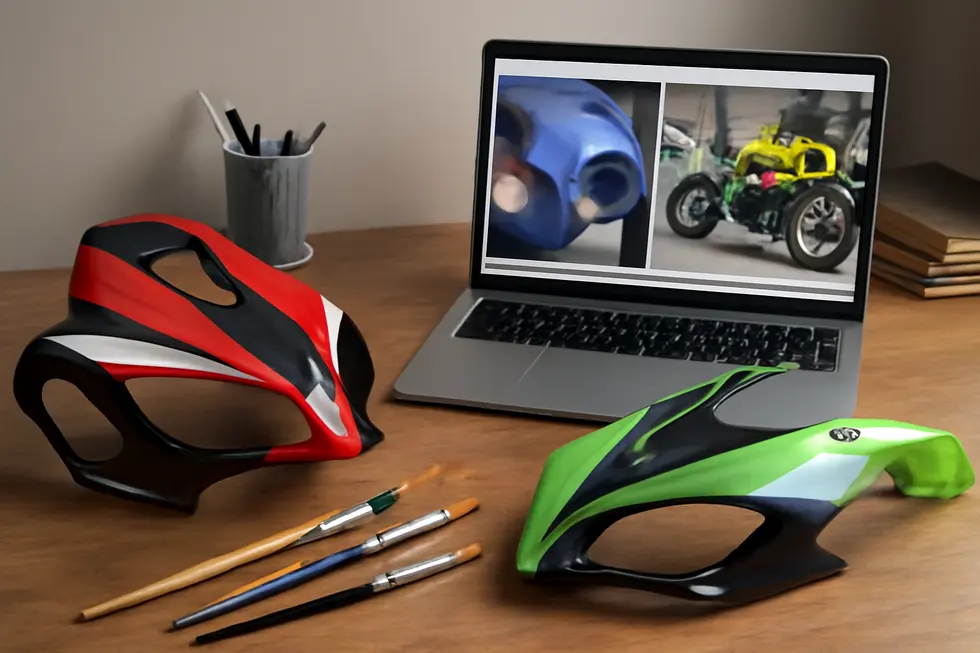
1. Mastering DIY Painting Techniques for Motorcycle Fairings: Affordable and Effective Customization
Painting motorcycle fairings yourself is an accessible way to personalize or repair your bike without heavy expenses. Critical to success is thorough surface preparation—cleaning, sanding, and using a primer tailored for plastic or fiberglass fairings—to ensure paint adheres properly and lasts. With readily available spray paint kits designed for automotive use, you can apply base coats and even add custom touches like glitter flakes, lace effects, or pinstriping. Finishing with a robust clear coat protects the paint from wear and weather while giving a glossy shine.
Many online tutorials offer step-by-step guidance, including detailed videos demonstrating dent repair and painting processes on fairings. These resources enable beginners to approach projects confidently and save on professional costs. For expansive customization options or complex artwork, professional shops deliver high-end finishes, but for most enthusiasts, DIY techniques strike a perfect balance of quality and affordability.
Explore accessible painting methods further at this comprehensive motorcycle painting tutorial and find additional inspiration on achieving vibrant, durable results for your ride. For more tips on fairing choices that complement your new paintwork, see our insights on discovering affordable motorcycle fairings.
2. Expert Craftsmanship and Customization: What Professional Motorcycle Fairing Paint Shops Bring to Your Bike
Professional custom paint shops specialize in transforming motorcycle fairings through expert craftsmanship, durable materials, and tailored artistic designs. These shops offer services ranging from complete repainting to intricate airbrushing, ensuring long-lasting finishes that resist fading and wear. Using multi-layer paint systems with protective clear coats, professionals enhance not only aesthetics but also the longevity of the paintwork, crucial for motorcycles exposed to outdoor elements. High-quality fitment and materials such as ABS plastic fairings are often paired with customization options like decals and pre-drilled kits to simplify assembly and enhance performance. Additionally, these shops typically provide guidance on proper preparation, paint types, and finishing techniques, supporting customers throughout the process. For riders seeking professional expertise, specialized paint services can elevate both daily riders’ and show bikes’ appearance. For further information or service inquiries, visiting a dedicated custom paint shop’s website can provide detailed options and customer support. Explore more about quality motorcycle fairings and customization at your ultimate source for affordable motorcycle fairings. External resource: https://www.psychoticair.com/motorcycle/
3. Mastering Advanced Repair and Finishing Techniques for Motorcycle Fairings: Expert Insights from Tutorials and Custom Paint Shops
Achieving a flawless paint finish on motorcycle fairings hinges on advanced repair and finishing techniques that go beyond basic application. This process starts with meticulous surface repair, involving crack and chip fillers and progressively finer sanding, usually from 180 to 320 grit, to create an ideal base. High-build primers, applied in multiple layers using spray guns, smooth imperfections and ensure strong paint adhesion. Selecting flexible, UV-resistant paints designed for plastics helps prevent cracking and fading, with multi-coat applications enhancing color depth and durability. The final clear coat seals the paint, adding gloss and environmental protection that withstands road wear. Custom paint shops elevate this craftsmanship with airbrushing, pin-striping, and graphics, often backed by lifetime guarantees reflecting confidence in their work. Notably, painting transparent parts like windshields should focus on edges to maintain visibility and safety. Enthusiasts can find step-by-step guidance in specialized tutorials demonstrating preparation, priming, and finishing techniques, complementing professional services for optimal results. For those interested in in-depth plastic fairing prep and priming details, exploring dedicated video tutorials can be invaluable: https://www.youtube.com/watch?v=MsHKbB4AJ0o and more insights on premium motorcycle fairings.
4. Exploring Diverse Customization Paths Beyond Painting in Motorcycle Fairing Services
When considering customization of motorcycle fairings, options extend well beyond traditional painting. Riders seeking a unique look can engage professional custom paint shops offering advanced techniques such as airbrushing and metallic finishes, which deliver striking, personalized designs with durable results. For enthusiasts who prefer hands-on work, extensive DIY tutorials are available online, guiding through surface preparation, priming, painting, and protective coating—empowering riders to tailor their fairings creatively and cost-effectively. Beyond custom painting, pre-made customizable fairing kits provide an appealing alternative, featuring OEM-fit parts in diverse colors and textures like faux carbon fiber, enabling easy assembly combined with personalization. Additionally, ordering pre-painted fairings from specialty suppliers offers convenience and quality, though these may require some modifications for perfect fitment. Together, these resources present a rich variety of paths allowing motorcycle owners to enhance their bikes’ aesthetics effectively. For those interested in purchasing pre-fitted and customizable fairings, valuable options can be explored at quality motorcycle fairing resources. Detailed service offerings are exemplified by providers specializing in pre-painted or custom kits with tailored fitments available at TMF Cycles.
5. Empowering Motorcycle Fairing Painting: From DIY Tutorials to Digital Marketing for Custom Shops
Painting motorcycle fairings is accessible to enthusiasts through a wealth of online DIY tutorials that cover everything from surface preparation to applying clear coats. These guides empower riders to restore or personalize their plastics affordably while providing step-by-step methods ideal for all skill levels. For those seeking premium finishes, custom paint shops offer advanced techniques including special effects and multi-layer finishes, achieved with professional-grade equipment and artistic expertise. Beyond the hands-on aspects, digital marketing plays a crucial role in helping restoration and paint shops expand their reach. Specialized agencies tailor SEO and social strategies to connect custom painters with targeted clients, boosting business growth in a competitive market. This synergy of DIY resources, expert services, and marketing support creates a comprehensive ecosystem that sustains and enriches the motorcycle fairing painting community. For detailed visual guidance, enthusiasts can explore tutorials such as How to Repair Paint Cracks in Motorcycle Fairings and discover more on restoration techniques. Additionally, exploring affordable motorcycle fairings complements the customization process by offering quality parts ready for painting.
Final thoughts
Painting motorcycle fairings represents a valuable opportunity for businesses to expand customization and repair offerings while enhancing customer satisfaction. Understanding the materials involved and the necessary preparation stages ensures that paint adheres properly and lasts over time. Deciding between DIY and professional methods helps align investment with quality expectations and operational capabilities. Protective finishing, particularly UV-resistant clear coats, protects the paint and extends the appeal of fairings exposed to environmental stressors. Leveraging tutorials and partnerships with custom paint shops offers ongoing learning and access to specialized techniques that can elevate service quality. By mastering these aspects, business owners can confidently offer painted motorcycle fairings that meet the dual demands of aesthetic appeal and durability, ultimately strengthening their market position and customer loyalty.
Ready to elevate your ride? Summit Fairings delivers premium, custom-fit fairings that blend style and durability. Whether you’re chasing speed or turning heads, we’ve got your bike covered. Don’t wait—transform your machine today. Click, customize, and ride with confidence. Your perfect fairing is just a few clicks away. Act now!
About us
undefined
RELATED POSTS
View all

